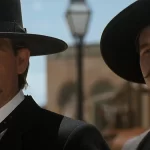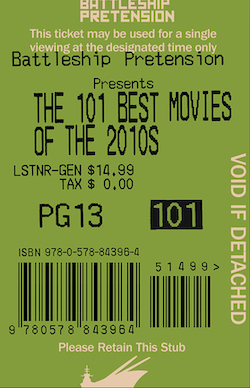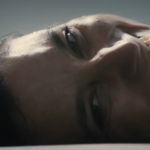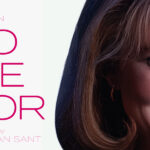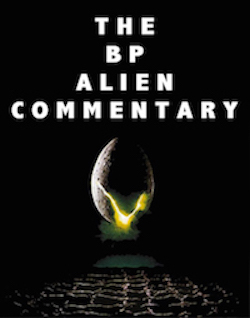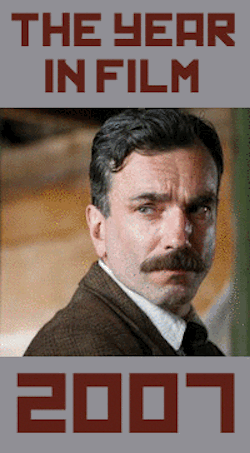Home Video Hovel- Gainsborough Melodramas, by Kyle Anderson
Britain’s Gainsborough Pictures existed for about 25 years beginning in 1924. They’d made dozens of films in that time period but never really achieved a great deal of popularity until the mid-40s when they started making a sequence of pulpy, escapist fare that have come to be known as “Gainsborough Melodramas,” and were some of the most financially successful films of the era, due to their intentional break with British Cinema’s realism of the time. They’re recognizable for their tawdry storylines usually based on romance novels written by female authors. They also feature a rotating cast of actors playing similar roles in each film. Criterion’s little brother Eclipse has released three of the best-regarded Gainsborough Melodramas in their Series 36: The Man in Grey (1943), Madonna of the Seven Moons (1945), and The Wicked Lady (1945). All three films are full of passion, intrigue, betrayal, adultery, murder, violence, and pretty much everything else the war-rattled British public were hungry for in a time of more somber films.
The Man in Grey, directed by Leslie Arliss, was the first film produced in the Melodrama cycle and is perhaps the most narratively intriguing. It begins in the present with Phyllis Calvert and Stewart Granger playing military personnel attending an auction of Early 19th Century art belonging to the Rohan family. Both people, it turns out, are descendents of people from the time period. We then flashback to the Regency Period where we find a girls’ school where well-to-do and kind-to-a-fault Clarissa (also played by Calvert) befriends the new young teacher, Hesther, (Margaret Lockwood). Hesther comes from nothing and has a huge chip on her shoulder against the wealthy and resents Clarissa, though they eventually become friends. Hesther runs off with a penniless ensign and Clarissa is heartbroken. She is eventually introduced to the incredibly wealthy but cold-hearted and rakish Lord Rohan (James Mason), the eponymous “Man in Grey.” He doesn’t much care for her, but thinks she’d make a good mother to his children and so proposes. After a chance meeting with dashing actor Rokeby (also Granger), Clarissa goes to see him in Othello and sees that Rokeby’s Desdemona is none other than her old friend Hesther. Wishing to give Hesther a better life than that of an actor (how low class!), she offers to hire her as her son’s live-in tutor. Rohan is at once taken with Hesther and the two begin an affair while Clarissa begins an affair with Rokeby. Society will not allow the marriage to be annulled and so Hesther hatches a plan to get rid of Clarissa and out of her way.
Here in the first of the films, the themes and character archetypes are introduced that would remain until the end of the cycle. There’s the innocent and beautiful heroine (usually played by Calvert or Patricia Roc), the devious and increasingly evil, but undoubtedly beautiful woman (usually played by Lockwood), the handsome rogue (played by Granger or Michael Rennie), and the dangerous villain (mostly Mason). It also begins the theme of mixing high society and costume drama with seediness and paperback romance. The Man in Grey was cut by nearly 30 minutes when released in the US simply for offenses against the Hays Code. Tame by today’s standards, but it’s odd to see a posh Englishman in a 1940s movie call a woman a “slut.” It also features a little, clearly white boy in blackface approximating a West Indian. It is not particularly easy to watch.
While the second film doesn’t feature overtly racist depictions, it does take place in Italy and has very English actors apparently supposed to be Italians. Madonna of the Seven Moons is the only one of the three films to take place entirely in modern day and is directed by Arthur Crabtree. In it, Calvert plays Maddalena, a young lady brought up in a convent and sent to marry a rich widower. Years later, the man’s daughter Angela (Patricia Roc) returns from boarding school Maddalena is shocked to see how “modern” she’s become, with regard to men and dealing with them. Angela, however, consents to be married to Englishman Evelyn (yeah, a dude named Evelyn) and upon hearing the news, Maddalena passes out and, after being left alone to rest, disappears and heads to Florence. It seems Maddalena has dual personalities and half of the time she believes herself to be the mistress of a gypsy jewel thief (Granger again).
Madonna of the Seven Moons acts much more as a mystery than the other two, but still contains the requisite intrigue and dime store plot contrivances. It has far too many characters than can be addressed here, but despite the denseness of the script, it actually all comes together quite well and the loose ends are sufficiently tied by the end. It has a lot less “action,” or any real violence until the end and is the most pedestrian, despite the wackiness of the split-personalities plot. This is my least favorite of the pack.
Rounding out the three discs is Leslie Arliss’ The Wicked Lady, a 17th Century yarn which has ample amounts of violence and backstabbing. On the eve of her wedding to handsome judge Sir Ralph Skelton (Griffith Jones), innocent and kind Caroline (Roc again) is visited by her dear friend Barbara (Lockwood again), the titular wicked lady. Sir Ralph is immediately attracted to Barbara, which the lady uses to undermine Caroline and marry the man herself, on the same wedding day, and has Caroline stay on as HER maid of honor. The nerve. At the wedding reception, Barbara meets the dashing Kit Locksby (Michael Rennie) who confesses to loving her at first sight and if only he’d met her a day sooner. Barbara immediately wants to change her state, but it’s too late. After six months of being married to the kind but boring Skelton (with Caroline still in her charge as handmaiden), Barbara decides to spice up her life by taking to the roads at night robbing carriages under the guise of being the famous highwayman, Jerry Jackson. She does this for a bit until she encounters the real Jackson (Mason again) who makes her his partner in crime and lover. Despite her fervor, Barbara’s actually pretty terrible at being a highwayman and resorts to murder a couple of times to prevent being uncovered, which Jackson absolutely abhors. When Locksby returns, having just proposed to Caroline, things get even stickier.
That Margaret Lockwood sure played evil, heartless women. Up to these films I’d only ever seen her in Hitchock’s The Lady Vanishes where she’s definitely not the bad guy. The Wicked Lady was Gainsborough’s biggest money-maker and the most financially successful film in Britain that year, beating out Hollywood pictures with much larger budgets. It also lead to both Lockwood and Mason being voted favorite actress and actor by the British public.
These films are interesting, if not quite masterpieces. They’re dressed-up and cultured B-movies, but the subject matter is still a little scandalous, especially given the time the films were produced. Like the Ealing Comedies, the Gainsborough Melodramas were a reaction to mainstream cinema in Britain and were there to titillate and thrill, something people have needed from their entertainment forever. As well-acted escapism, and because they represent a slice of the British film industry in a very tumultuous time, these three films are well worth a look.




